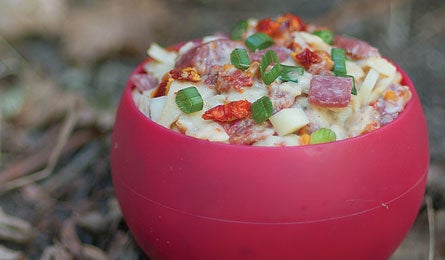Ski Strong: Stay Fueled

'Stay Fuled: Alpine Pasta'
Beat Blisters | Going Up on Skins | Stay Fueled
Ski Any Conditions | Adjust Your Poles | Descend With Control
Kick-Turn Like a Pro
DRINK
>> Altitude accelerates dehydration because it’s desert-dry, so you breathe harder (and if you’re taking Diamox, you pee more). In fact, water loss through respiration alone can occur twice as fast at altitude than at sea level. Try to down three to four liters of water per day.
>> Hydration bladder tubes may freeze, and as temps drop, even insulated hoses and bite valves may ice up. Fill your reservoir with warm water and route the hose close to your body. After drinking, blow into the bite valve to push the water down the tube and back into the reservoir.
>> Really cold? If it’s below 15°F, ditch the bladder for double-walled or wide-mouth bottles (tucked into an insulated sleeve or deep in your pack). Water will stay liquid longer in a wide bottle. Tip: Add electrolytes (and comfort) by packing at least one bottle of hot, sweet tea.
EAT
>> If you’re day-touring at moderate altitudes (below 8,000 feet), try for a ratio of 50 percent carbs, 30 percent fat, and 20 percent protein. Going higher? Change the ratio to 65:25:10. Burning fat requires more oxygen than burning carbs, so a lower-fat fuel mix is less taxing to exploit.
>> Plan to consume 3,000 to 3,500 calories per full day. Exertion at high altitude (usually above 8,000 feet) can cause low oxygen levels in the blood (hypoxia). As a result, your body shunts oxygen from your digestive system to critical organs like your heart, lungs, and brain—which will dampen your appetite. Plan to eat at scheduled times or at specific landmarks, to ensure you’re consuming enough calories. Shivering? Up your intake even more. Shivering can burn up to 400 calories an hour.
>> Nutrient absorption can drop 15 percent at altitude, as a result of hypoxia. Stay energized by eating whatever tastes best. Bring both salty and sweet snacks so that if your appetite flounders, you have tempting options. If your energy is flagging, it’s more important to get calories in any form than to worry about where they come from or their fat-carb ratio.
>> Need a boost? Pure sugar is absorbed quickly. Carry a handful of jellybeans or hard candies (they’ll be edible at any temp) for your summit push. Energy gels can freeze.